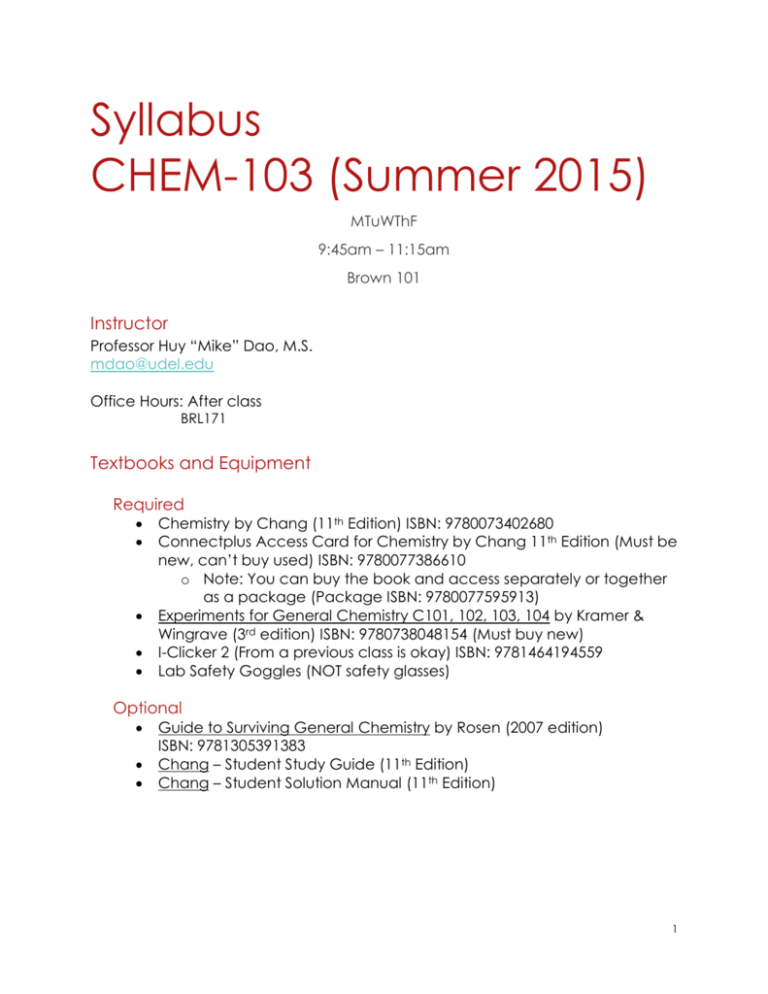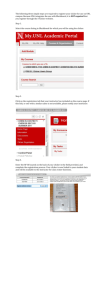CHEM103 General Chemistry (Dao)
advertisement

Syllabus CHEM-103 (Summer 2015) MTuWThF 9:45am – 11:15am Brown 101 Instructor Professor Huy “Mike” Dao, M.S. mdao@udel.edu Office Hours: After class BRL171 Textbooks and Equipment Required Chemistry by Chang (11th Edition) ISBN: 9780073402680 Connectplus Access Card for Chemistry by Chang 11th Edition (Must be new, can’t buy used) ISBN: 9780077386610 o Note: You can buy the book and access separately or together as a package (Package ISBN: 9780077595913) Experiments for General Chemistry C101, 102, 103, 104 by Kramer & Wingrave (3rd edition) ISBN: 9780738048154 (Must buy new) I-Clicker 2 (From a previous class is okay) ISBN: 9781464194559 Lab Safety Goggles (NOT safety glasses) Optional Guide to Surviving General Chemistry by Rosen (2007 edition) ISBN: 9781305391383 Chang – Student Study Guide (11th Edition) Chang – Student Solution Manual (11th Edition) 1 Class Description & Goals This course focuses on matter, the changes that matter undergoes, and the laws governing these changes. Special emphasis is placed on atomic and molecular structure, stoichiometry, periodic properties of elements, bonding, molecular geometry, and energy relationships. After successfully completing this course, a student should be able to: 1. 2. 3. 4. 5. Define pertinent terms relating to the study of general chemistry Identify the physical/chemical properties/changes of matter Determine the number of significant figures in values and calculations Understand the historical development of the atomic theory Write formulas and names of chemical compounds and balance equations 6. Perform calculations in stoichiometric relationships 7. Calculate answers to fundamental gas law problems 8. Apply energy changes in thermochemistry to the solving of problems, including Hess’s Law 9. Identify the characteristics of the modern quantum theory to the model of the atom including electron configuration 10. Determine the relationship of the elements and their positions on the periodic table, including all physical and chemical characteristics 11. Calculate the bonding character of compounds using electronegativity 12. Determine the three dimensional structure of compounds using the VSEPR model 13. Define the characteristics of the kinetic theory of matter as related to phase diagrams Goals adopted from Dr. Michael Stemniski Attendance Attendance is based on a 3-strike policy. You are allowed 3 unexcused absences throughout the semester. For each additional unexcused absence beyond the given 3, your final grade will be lowered by one grade level (A- B+). Attendance is taken via clicker questions. The clicker questions may occur at any point in the class period. If you are not present to answer the clicker question, you are considered absent for that day. 2 Excused Absences Excused absences are those covered by the University’s attendance policy, including serious illness and death in the immediate family. For an absence to be considered excused, a doctor’s note or other relevant documentation must be provided. Grading There are 800 points in the class. Lecture is worth 600 points, and laboratory is worth 200 points. Exam 1 – 100 points Exam 2 – 100 points Exam 3 – 100 points Final – 200 points Homework – 75 points Clickers – 25 points Lab – 200 points Your laboratory grade will be calculated by multiplying your percentage grade by 2. A 95% in laboratory would produce a point score of 190 (out of 200). Grade A AB+ Points 744 - 800 720 - 743 696 - 719 B 664 - 695 B- 640 - 663 Grade C+ C C- Points 616 - 639 584 - 615 560 - 583 Grade D+ D D- Points 536 - 559 504 - 535 480 - 503 F Less than 480 Exams There are 3 exams and 1 final. Exams must be taken on the scheduled day, at the scheduled time. There are no make-ups. Tentative schedule: Exam 1 – Thursday June 18, 2015 Exam 2 – Thursday June 25, 2015 Exam 3 – Thursday July 2, 2015 Final Exam – Saturday July 11, 2015 (time TBA) 3 Homework Assignments Homework will be done through McGraw-Hill Connect. You can receive a maximum of 75 points from homework. The points will come from the percentage of questions you answer correctly. http://connect.mheducation.com/class/m-dao-chem103-summer-1-2015 Homework is considered to be individual, and group work / sharing answers is not permitted. Clicker Questions Clicker questions are both a form of evaluation and a method to take attendance. You can receive a total of 25 clicker points. A correct clicker answer is worth 1.25 points, and an incorrect answer is worth 1 point. Using another student’s clicker to answer clicker questions is considered cheating and is a violation of the University’s academic code. Clickers must be registered on Sakai in order to properly connect responses to specific students. UD Course Capture Lectures will be recorded via UD Course Capture. UD Course Capture will have video of the slides and audio from the lecture. It will not record anything written on the board. Therefore, attendance is still mandatory. The link to the videos will be posted on Sakai as soon as it is available from Academic Technology Services. 4 Laboratory This course includes 12 laboratory exercises. There are 11 exercises that take place during the lab period, and 1 that is take-home. All labs must be completed and handed in during lab or on the date specified for the takehome lab. The lowest lab grade will be dropped. An absence will count as a zero, and will be used as your dropped lab. Labs will be MWF, 12:30-3:30. Section 020 will be in 064 Drake. Section 021 will be in 070 Drake. The tentative lab schedule is as follows: June 10th: Experiment 1, Laboratory Techniques June 12th: Experiment 2, Density June 15th: Experiment 3, Physical and Chemical Properties June 17th: Experiment 5, Properties of Hydrates June 19th: Experiment 6, Limiting Reactants June 22nd: Experiment 13, Types of Reactions June 24th: Experiment 15, Thermodynamics, Calorimetry June 26th: Experiment 32, Phosphates in Water June 29th: Experiment 9, Trends in the Periodic Table July 1st: Experiment 10, Spectroscopy July 6th: Experiments 11&12 Lewis Structures and Using Lewis Structures (Do 11 in lab, finish 12 at home, unless finished in lab) Academic Dishonesty Cheating is not tolerated. All UD students are required to be familiar with and abide by the Student Code of Conduct as promulgated in The Official Student Handbook http://www.udel.edu/stuguide/13-14/code.html#honesty. This policy will apply to every exam, quiz, homework, and any other assignment given in this course. Violations of any kind can result in a failing grade for the course. During exams, all mobile communications devices (cell phones, tablets, mp3 players, laptop computers, etc…) must be silenced or turned off. Any use of a cell phone will result in a zero for the exam and possible sanctions by the Office of Student Conduct. No other resources are allowed, include any notes, written or typed. 5 Syllabus I reserve the right to change the information and/or assignments contained within this syllabus. Please ask if there are any questions about the syllabus or course. 6







